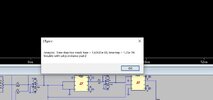Hello. I am new to LT spice and I am having a lot of trouble simulating a duffing oscillator. I‘ve tried changing integration methods, changing tolerances, using .startup, using .uic, and lots of other things.
I get two different errors depending on my settings (see image):
1) time step too small without .uic
2) singular matrix with .uic
any help is much appreciated. I have included images of the errors, my .asc, as well as the paper that this is based on which includes the circuit diagram. Note that I am using an LF356 op amp. I know that my .include says LF3562, but the ’2’ is just due to me changing the name of the .sub file.
I get two different errors depending on my settings (see image):
1) time step too small without .uic
2) singular matrix with .uic
any help is much appreciated. I have included images of the errors, my .asc, as well as the paper that this is based on which includes the circuit diagram. Note that I am using an LF356 op amp. I know that my .include says LF3562, but the ’2’ is just due to me changing the name of the .sub file.


